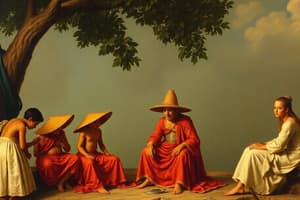Podcast
Questions and Answers
Who wrote the 'Customs of the Tagalogs' in 1589?
Who wrote the 'Customs of the Tagalogs' in 1589?
- Santiago
- Lapu-Lapu
- Rizal
- Juan de Plasencia (correct)
What term did Plasencia use for the Tagalog natives?
What term did Plasencia use for the Tagalog natives?
Indians; indio
What are Tagalog chieftains called?
What are Tagalog chieftains called?
Datos
In which town was Juan de Plasencia born?
In which town was Juan de Plasencia born?
What is the typical number of houses governed by datos?
What is the typical number of houses governed by datos?
What is the name of the first book printed in the Philippines?
What is the name of the first book printed in the Philippines?
There were many of these barangays in each town, or, at least, on account of wars, they ___ from one another.
There were many of these barangays in each town, or, at least, on account of wars, they ___ from one another.
When did Juan de Plasencia die?
When did Juan de Plasencia die?
What were the nobles or free-born called?
What were the nobles or free-born called?
The slaves are called ___.
The slaves are called ___.
Match the following roles with their descriptions in Tagalog society:
Match the following roles with their descriptions in Tagalog society:
How long did the feast for worship usually last?
How long did the feast for worship usually last?
Who were instrumental in organizing communities during early Spanish colonization?
Who were instrumental in organizing communities during early Spanish colonization?
Badhala signifies "" or "".
Badhala signifies "" or "".
Flashcards
Who was Juan de Plasencia?
Who was Juan de Plasencia?
A Spanish friar who arrived in the Philippines in 1577 and documented Tagalog customs in his work 'Customs of the Tagalogs'.
What does "Indians" or "indio" refer to?
What does "Indians" or "indio" refer to?
The term used by Juan de Plasencia to refer to the Tagalog natives in his writings.
Who were the "datos"?
Who were the "datos"?
The leaders of Tagalog communities, typically governing 30-100 families.
What were the main social groups in Tagalog society?
What were the main social groups in Tagalog society?
Signup and view all the flashcards
Who were the "maharlica"?
Who were the "maharlica"?
Signup and view all the flashcards
Who were the "aliping namamahay"?
Who were the "aliping namamahay"?
Signup and view all the flashcards
Who were the "aliping sa guiguilir"?
Who were the "aliping sa guiguilir"?
Signup and view all the flashcards
How was land ownership organized in Tagalog society?
How was land ownership organized in Tagalog society?
Signup and view all the flashcards
How were disputes among Tagalog chiefs resolved?
How were disputes among Tagalog chiefs resolved?
Signup and view all the flashcards
How was inheritance handled in Tagalog society?
How was inheritance handled in Tagalog society?
Signup and view all the flashcards
What were dowries in Tagalog marriage?
What were dowries in Tagalog marriage?
Signup and view all the flashcards
What did "inasava" represent in Tagalog society?
What did "inasava" represent in Tagalog society?
Signup and view all the flashcards
What were some core beliefs of the Tagalog people?
What were some core beliefs of the Tagalog people?
Signup and view all the flashcards
Why is 'Customs of the Tagalogs' significant?
Why is 'Customs of the Tagalogs' significant?
Signup and view all the flashcards
Study Notes
Juan de Plasencia
- Spanish friar who authored 'Customs of the Tagalogs' in 1589.
- Born in the Spanish town of Plasencia; arrived in the Philippines in 1577 via Mexico.
- Established several towns in regions like Laguna de Bay, Bulacan, and Tayabas.
- Converted many Tagalog natives to Christianity and wrote 'Doctrina Cristiana', the first book printed in the Philippines.
Tagalog Society
- Term "Indians" or "indio" used by Plasencia to refer to Tagalog natives.
- Tagalog chieftains referred to as "datos", governing 30-100 houses in their areas.
- Social structure included castes: nobles (maharlica), commoners, and slaves (aliping).
Nobility and Commoners
- Nobles (maharlica) are free-born individuals who do not pay tributes but must accompany the dato in war at their own expense.
- Commoners (aliping namamahay) are married and work half their cultivated lands for their master.
- Slaves (aliping sa guiguilir) serve their masters and may be sold.
Land Ownership
- Lands are owned in common by the barangay, especially irrigated portions, known only to the grupo.
- Nobles in villages like Pila de la Laguna paid annual tribute to the datu, such as a hundred gantas of rice.
- Land cultivation was regulated by the barangay, with inheritance and purchase rules in place.
Governance and Justice
- Disputes among chiefs were settled by judges or arbiters to avoid war.
- No one could be condemned to slavery without just cause, typically meriting a death penalty.
- Legitimate children inherited equally, except in cases of parental favoritism.
Marriage and Dowries
- Dowries were presented by men to the families of women.
- In cases of childless death, families retrieved part of the dowry.
- An unmarried woman in a relationship is referred to as "inasava".
Religious Practices
- Worship involved a temple (simbahan) and decorative lamps (sorihile) used during rituals.
- Festivals (pandot) and temporary shelters (sibi) were constructed for communal gatherings.
- The nagaanitos celebration involved drumming for four days, uniting the barangay in worship.
Cultural Beliefs
- Badhala was a deity among the Tagalogs, signifying "all powerful" or "maker of all things".
- The customs documented in 'Customs of the Tagalogs' reflect early Philippine spirituality and community structure.
Key Historical Facts
- 'Customs of the Tagalogs' was written in 1589.
- Juan de Plasencia died in 1590 in Liliw, Laguna.
- Spanish friars played a crucial role in community organization during the early years of colonization.
Studying That Suits You
Use AI to generate personalized quizzes and flashcards to suit your learning preferences.




